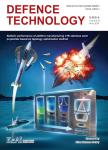Dimensional analysis and extended hydrodynamic theory applied to long-rod penetration of ceramics
Dimensional analysis and extended hydrodynamic theory applied to long-rod penetration of ceramics作者机构:Impact Physics RDRL-WMP-C US Army Research Laboratory Aberdeen Proving Ground A.James Clark School of Engineering University of Maryland College Park
出 版 物:《Defence Technology(防务技术)》 (Defence Technology)
年 卷 期:2016年第12卷第4期
页 面:334-342页
核心收录:
学科分类:08[工学] 0806[工学-冶金工程] 0817[工学-化学工程与技术] 0826[工学-兵器科学与技术] 082603[工学-火炮、自动武器与弹药工程] 0805[工学-材料科学与工程(可授工学、理学学位)] 0802[工学-机械工程] 0703[理学-化学] 0701[理学-数学] 0801[工学-力学(可授工学、理学学位)] 0702[理学-物理学]
主 题:Ceramics Terminal ballistics Armor Dimensional analysis Hydrodynamics
摘 要:Principles of dimensional analysis are applied in a new interpretation of penetration of ceramic targets subjected to hypervelocity impact. The analysis results in a power series representation – in terms of inverse velocity – of normalized depth of penetration that reduces to the hydrodynamic solution at high impact velocities. Specifically considered are test data from four literature sources involving penetration of confined thick ceramic targets by tungsten long rod projectiles. The ceramics are AD-995 alumina, aluminum nitride, silicon carbide, and boron carbide.Test data can be accurately represented by the linear form of the power series, whereby the same value of a single fitting parameter applies remarkably well for all four ceramics. Comparison of the present model with others in the literature(e.g., Tate s theory) demonstrates a target resistance stress that depends on impact velocity, linearly in the limiting case. Comparison of the present analysis with recent research involving penetration of thin ceramic tiles at lower typical impact velocities confirms the importance of target properties related to fracture and shear strength at the Hugoniot Elastic Limit(HEL) only in the latter. In contrast, in the former(i.e., hypervelocity and thick target) experiments, the current analysis demonstrates dominant dependence of penetration depth only by target mass density. Such comparisons suggest transitions from microstructure-controlled to density-controlled penetration resistance with increasing impact velocity and ceramic target thickness.Production and hosting by Elsevier B.V. on behalf of China Ordnance Society.



